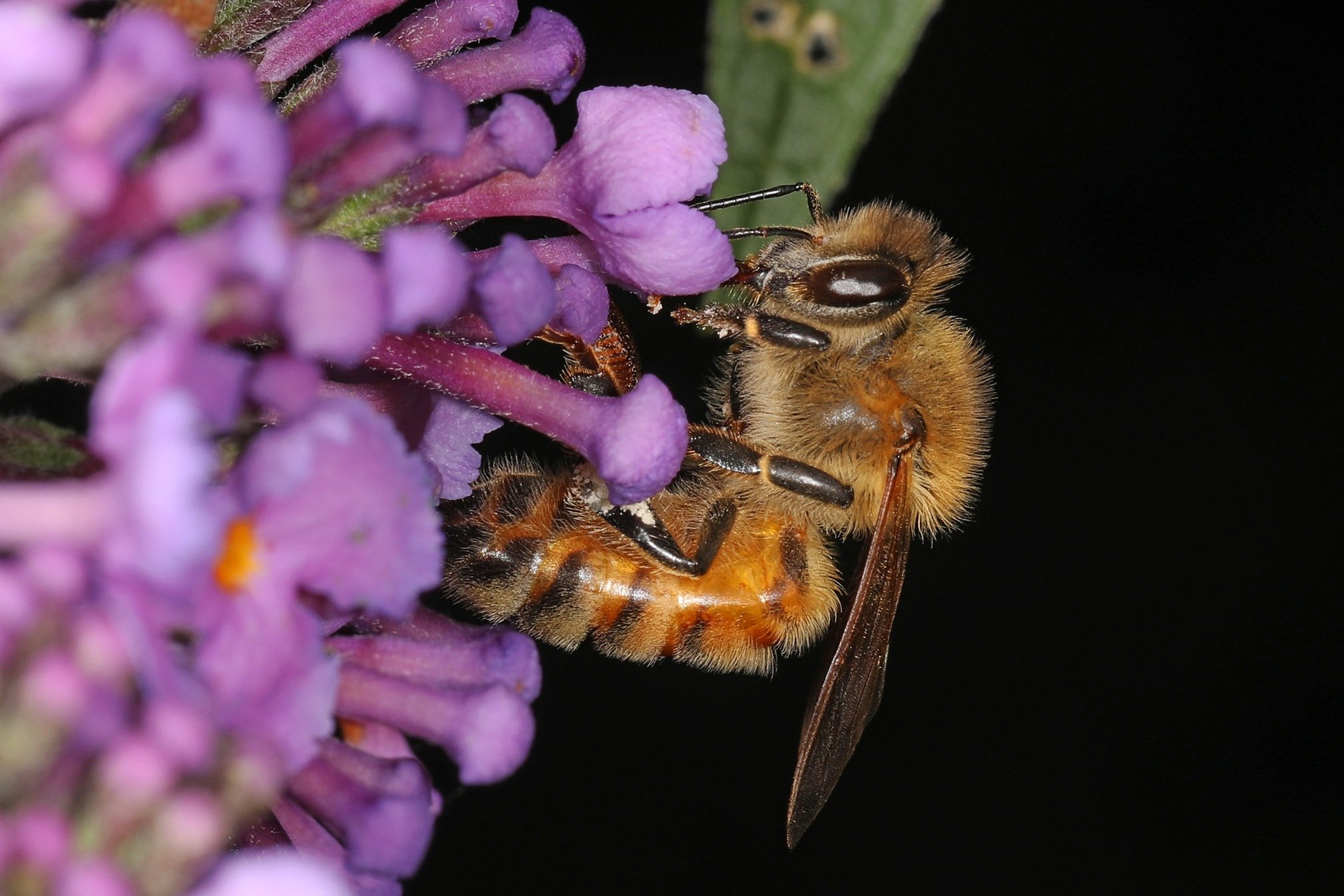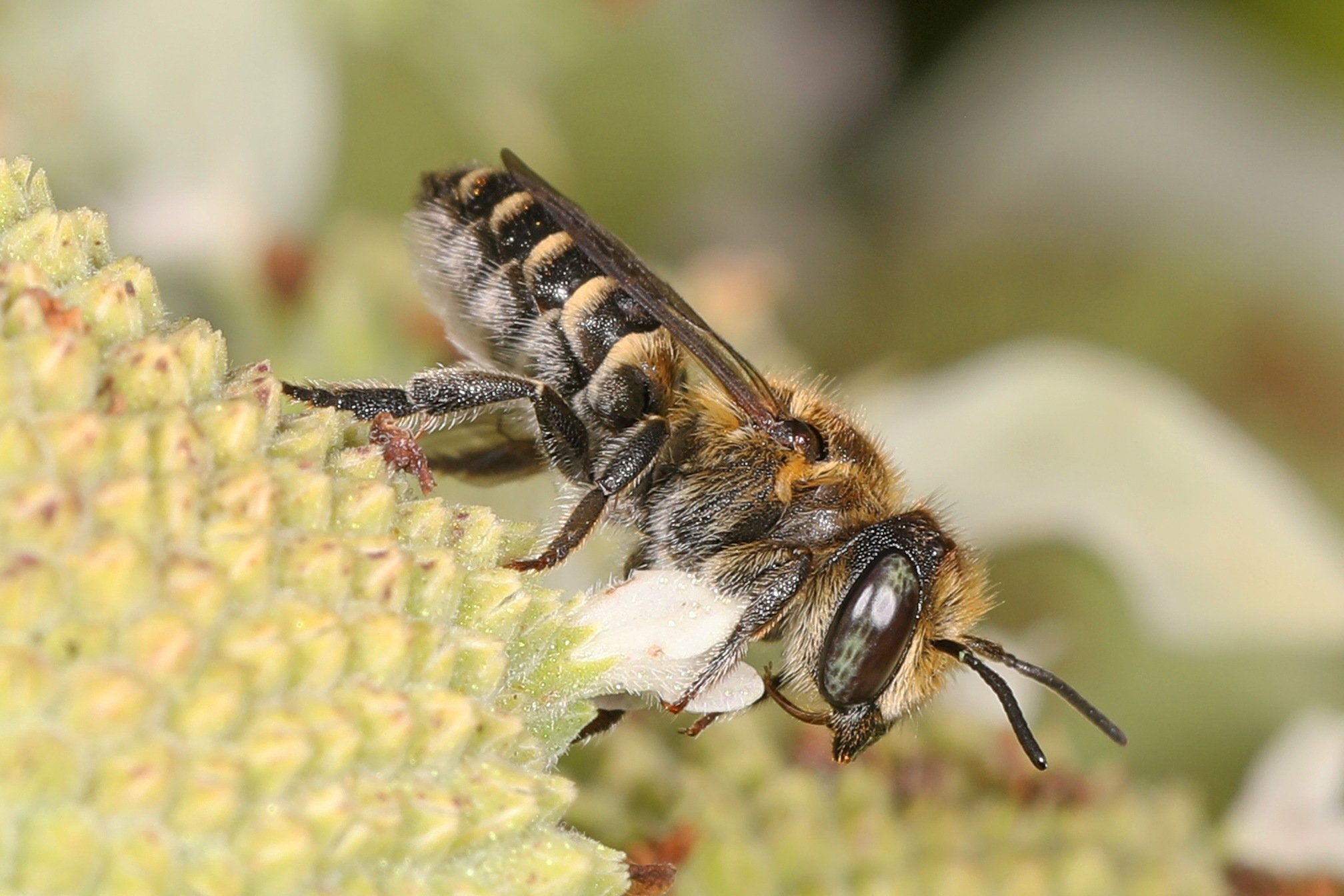Photo: Dilemma Orchid Bee, Judy Gallagher
Judy Gallagher is an ASNV board member and a regular surveyor of local wildlife who also captures photos of what she sees, in particular the less common species.
Dilemma Orchid Bee showing its long tongue , Judy Gallagher
I was recently in Florida, where I saw a Dilemma Orchid Bee with an incredibly long tongue. Dilemma Orchid Bees use their tongues, which are about 3/4 of the length of their bodies, to gather nectar from orchids and other deep-throated flowers. The flower produces nectar as a reward for pollination. The bee gets nectar, and then transfers the flower's pollen from flower to flower.
Bee mouthparts vary by species, depending on the bee's lifestyle. For instance, Leafcutter Bees have sharp teeth for cutting the leaves that they use to line their nest. Carpenter Bees chew wood, so need jaws suitable for grinding down wood. Honey Bee mouthparts have broad flat tips that they use to spread and shape wax. These mouthparts are called mandibles.
Brown-belted Bumble Bee folding up tongue, Judy Gallagher
The tongue comes out below the mandibles. Muscles at the bottom of the tongue pump nectar from a flower to the bee's mouth. Long-tongued bees’ tongues are jointed, and fold up inside the mouth when the bee is not nectaring. Short-tongued bees' tongues don't fold, and they typically lap up rather than suck up nectar.
Western Honey Bee sucking up nectar from a long-tubed flower, Judy Gallagher
But some bees, like our familiar Western Honey Bee, can do both. If the flower's nectar is sugary thick or plentiful, bees lap up the nectar. If the nectar is watery or pooled deep within a flower, they suck up the nectar. This means that Western Honey Bees can nectar from a much larger variety of flowers than most other bees.
Alfalfa Leafcutter Bee showing its tongue, Judy Gallagher
Bees taste with sensilla, hair-like structures that are sensitive to specific substances. They are located on their mouthparts, antennae, and at the end of their legs. Primitive flowers were shallow, and access to pollen and nectar was easy for bees and other insects. As time went by, some flowers evolved to have deeper throats, and, in order to take advantage of these flowers, insects, including bees, needed to evolve mouthparts that could access them. Bees are now classified as either long-tongued or short-tongued bees, but that does not necessarily correlate with tongue length. In long-tongued bees, the two segments that are closest to the bee's head are longer than the second two segments, and in short-tongued bees, all segments are approximately the same length. Bee families Megachilidae (mason bees, leafcutter bees, and resin bees) and Apidae (bumble bees, honey bees, and nomad bees) are considered to be long-tongued, and the rest of the bee families are defined as short-tongued. It is worth mentioning that it is quite challenging to measure a bee's tongue length, and tongue length is not known for all of the world's species.
Golden Sweat Bee, with an unusually detailed look at its short tongue, Judy Gallagher
Some nectar is eaten by the bee, but some is used for the benefit of their young. Foraging Honey Bees return to their hive, open their mandibles to bees living within the hive and transfer drops of nectar to them. The receiving bee adds more saliva to the nectar, and then it will be placed into a honey storage cell. Some solitary bees mix nectar with pollen for their young.
Modest Masked Bee, with a short tongue, Judy Gallagher
The Masked Bees have short tongues, suitable for nectaring from very shallow flowers. The Dilemma Orchid Bee, mentioned earlier, has a long tongue suitable for nectaring from long-necked orchids. Some bees are generalists, nectaring on a wide range of plants, and they usually have all-purpose tongues suitable for accessing different types of flowers. Specialist bees usually have tongues designed to fit their favorite flowers.
Wavy Mucksucker , Judy Gallagher
So, what happens when a bee isn't able to find a nectar source suitable for its particularly tongue? Sometimes that is bad news for the bee, but some, like this Eastern Carpenter Bee, have learned to "nectar rob." Rather than entering the flower's natural opening, the bee drills a hole in the flower to access the nectar. This means that it bypasses all the pollination structures. It gets a nectar reward, but does not provide pollination services. Nature is wonderful and fascinating!
View more of Judy’s Observations from Meadowood articles here.








